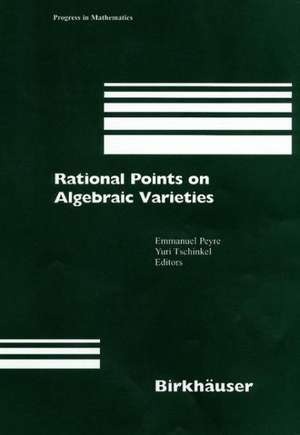Rational Points on Algebraic Varieties: Zweite, aktualisierte und erweiterte Auflage: Progress in Mathematics, cartea 199
Editat de Emmanuel Peyre, Yuri Tschinkelen Limba Engleză Paperback – 23 oct 2012
| Toate formatele și edițiile | Preț | Express |
|---|---|---|
| Paperback (1) | 952.72 lei 6-8 săpt. | |
| Birkhäuser Basel – 23 oct 2012 | 952.72 lei 6-8 săpt. | |
| Hardback (1) | 958.88 lei 6-8 săpt. | |
| Birkhäuser Basel – oct 2001 | 958.88 lei 6-8 săpt. |
Din seria Progress in Mathematics
- 24%
 Preț: 740.79 lei
Preț: 740.79 lei -
 Preț: 308.20 lei
Preț: 308.20 lei - 20%
 Preț: 695.88 lei
Preț: 695.88 lei -
 Preț: 362.51 lei
Preț: 362.51 lei -
 Preț: 308.13 lei
Preț: 308.13 lei - 18%
 Preț: 749.27 lei
Preț: 749.27 lei - 9%
 Preț: 766.41 lei
Preț: 766.41 lei - 20%
 Preț: 631.08 lei
Preț: 631.08 lei - 24%
 Preț: 638.86 lei
Preț: 638.86 lei - 15%
 Preț: 580.82 lei
Preț: 580.82 lei -
 Preț: 392.37 lei
Preț: 392.37 lei -
 Preț: 395.09 lei
Preț: 395.09 lei -
 Preț: 376.80 lei
Preț: 376.80 lei -
 Preț: 390.25 lei
Preț: 390.25 lei - 18%
 Preț: 729.53 lei
Preț: 729.53 lei - 15%
 Preț: 652.49 lei
Preț: 652.49 lei - 15%
 Preț: 649.22 lei
Preț: 649.22 lei - 18%
 Preț: 897.95 lei
Preț: 897.95 lei -
 Preț: 385.08 lei
Preț: 385.08 lei -
 Preț: 391.02 lei
Preț: 391.02 lei -
 Preț: 378.54 lei
Preț: 378.54 lei - 15%
 Preț: 531.59 lei
Preț: 531.59 lei - 15%
 Preț: 642.83 lei
Preț: 642.83 lei - 15%
 Preț: 650.69 lei
Preț: 650.69 lei -
 Preț: 381.21 lei
Preț: 381.21 lei -
 Preț: 392.37 lei
Preț: 392.37 lei -
 Preț: 398.53 lei
Preț: 398.53 lei - 15%
 Preț: 699.28 lei
Preț: 699.28 lei -
 Preț: 416.92 lei
Preț: 416.92 lei -
 Preț: 385.84 lei
Preț: 385.84 lei - 18%
 Preț: 902.65 lei
Preț: 902.65 lei - 18%
 Preț: 802.28 lei
Preț: 802.28 lei - 15%
 Preț: 640.06 lei
Preț: 640.06 lei - 18%
 Preț: 1129.83 lei
Preț: 1129.83 lei - 15%
 Preț: 494.03 lei
Preț: 494.03 lei - 15%
 Preț: 593.08 lei
Preț: 593.08 lei
Preț: 952.72 lei
Preț vechi: 1161.85 lei
-18% Nou
Puncte Express: 1429
Preț estimativ în valută:
182.35€ • 189.65$ • 152.81£
182.35€ • 189.65$ • 152.81£
Carte tipărită la comandă
Livrare economică 13-27 martie
Preluare comenzi: 021 569.72.76
Specificații
ISBN-13: 9783034895361
ISBN-10: 3034895364
Pagini: 468
Ilustrații: XVI, 446 p.
Dimensiuni: 155 x 235 x 25 mm
Greutate: 0.65 kg
Ediția:Softcover reprint of the original 1st ed. 2001
Editura: Birkhäuser Basel
Colecția Birkhäuser
Seria Progress in Mathematics
Locul publicării:Basel, Switzerland
ISBN-10: 3034895364
Pagini: 468
Ilustrații: XVI, 446 p.
Dimensiuni: 155 x 235 x 25 mm
Greutate: 0.65 kg
Ediția:Softcover reprint of the original 1st ed. 2001
Editura: Birkhäuser Basel
Colecția Birkhäuser
Seria Progress in Mathematics
Locul publicării:Basel, Switzerland
Public țintă
ResearchCuprins
Diagonal cubic equations in four variables with prime coefficients.- References.- Rational points on cubic surfaces.- 1. Notations and preliminaries.- 2. Ternary quadratic forms.- 3. Proof of the main theorem.- References.- Torseurs arithmétiques et espaces fibrés.- Notations et conventions.- 1. Torseurs arithmétiques.- 2. Espaces fibrés.- Références.- Fonctions zêta des hauteurs des espaces fibrés.- Notationset conventions.- 3. Fonctions holomorphes dans un tube.- 4. Variétés toriques.- 5. Application aux fibrations en variétés toriques.- Appendice A. Un théorème taubérien.- Appendice B. Démonstration de quelques inégalités.- Références.- Hasse principle for pencils of curves of genus one whose Jacobians have a rational 2-division point, close variation on a paper of Bender and Swinnerton-Dyer.- Statement of the Theorems.- 1. Selmer groups associated to a degree 2 isogeny.- 2. Proof of Theorem A.- 3. Proof of Theorem B.- References.- Enriques surfaces with a dense set of rational points, Appendix to the paper by J.-L. Colliot-Thélène.- References.- Density of integral points on algebraic varieties.- 1. Generalities.- 2. Geometry.- 3. The fibration method and nondegenerate multisections.- 4. Approximation techniques.- 5. Conic bundles and integral points.- 6. Potential density for log K3 surfaces.- References.- Composition of points and the Mordell–Weil problem for cubic surfaces.- 1. Introduction.- 2. Cardinality of generators of subgroups in a reflection group.- 3. Structure of universal equivalence.- 4. A group–theoretic description of universal equivalence.- 5. Birationally trivial cubic surfaces: a finiteness theorem.- References.- Torseurs universels et méthode du cercle.- 1. Une version raffinée d’une conjecture de Manin.- 2. Passageau torseur universel.- 3. Intersections complètes.- 4. Conclusion.- Références.- Tamagawa numbers of diagonal cubic surfaces of higher rank.- 1. Description of the conjectural constant.- 2. The Galois module Pic($$\bar{V}$$).- 3. Euler product for the good places.- 4. Density at the bad places.- 5. The constant a(V).- 6. Some statistical formulae.- 7. Presentation of the results.- References.- The Hasse principle for complete intersections in projective space.- References.- Une construction de courbes k-rationnelles sur les surfaces de Kummer d’un produit de courbes de genre 1..- 1. Relèvement des courbes de P1,k × P1,k sur la surface de Kummer.- 2. Exemples.- Références.- Arithmetic Stratifications and Partial Eisenstein Series.- 1. The fibre bundles: geometric-arithmetic preliminaries.- 2. Height zeta functions.- 3. Arithmetic stratification.- References.- Weak Approximation and R-equivalence on Cubic Surfaces.- 1. Introduction.- 2. Geometric background.- 3. Approximation at an infinite prime.- 4. Approximation at a finite prime.- 5. The lifting process.- 6. The dense lifting process.- 7. Adelic results.- 8. Surfaces X13 + X23 + X33 ? dX03 = 0.- References.- Hua’s lemma and exponential sums over binary forms.- 1. Introduction.- 2. Preliminary reductions.- 3. Integral points on affine plane curves.- 4. The inductive step.- 5. The completion of the proof of Theorem 1.1.- References.















